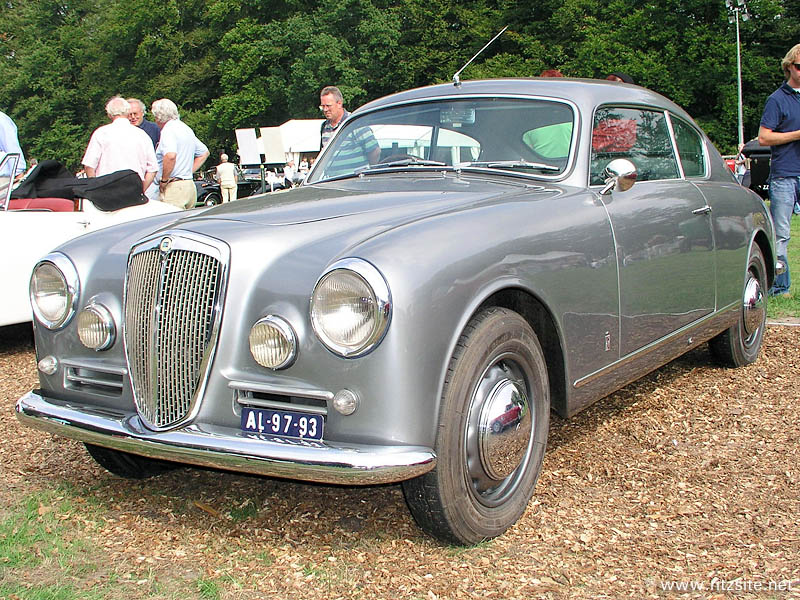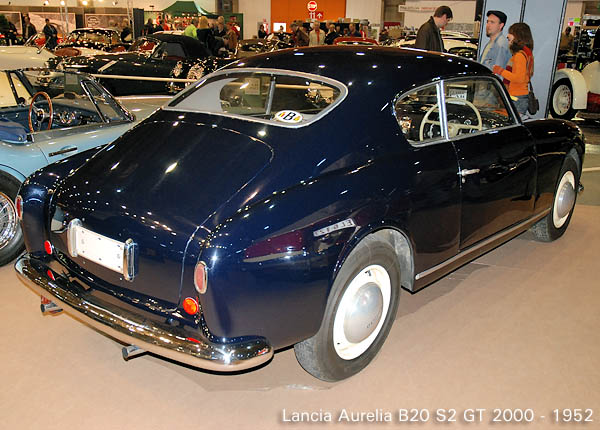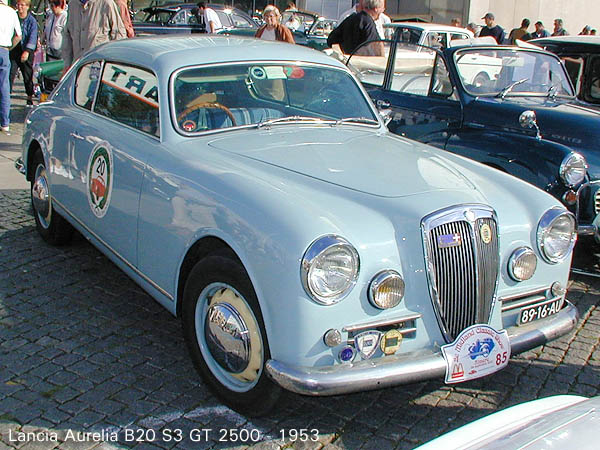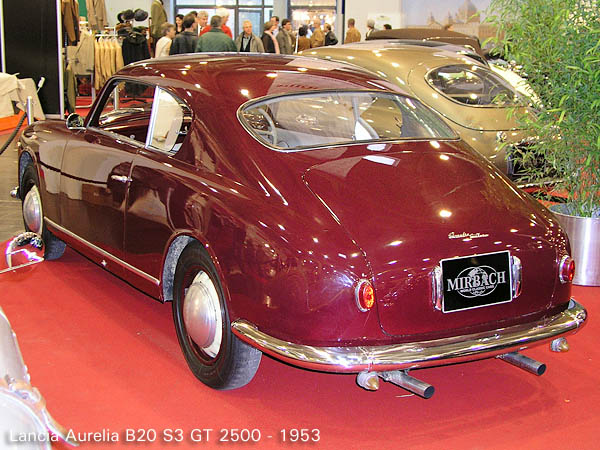
The first new car to appear from Lancia after World War 2 was the Aurelia. It replaced the Aprilia, a design from 1936 developed under the direction of company founder Vincenzo Lancia, in 1950. It was a pillarless 4-door sedan (berlina) model with opposing opening doors and a roomy interior. In good Lancia tradition it had not only original looks but also featured some innovative engineering.
Most important innovation was the introduction of a V6 engine in a production model. This was a first in the world because, unlike a V8, V6 engines of traditional design suffered from terrible vibrations. The Lancia V6 engine however had a completely new crankshaft design which balanced the vibrations out at an angle of 60 degrees between the two rows of cylinders. Advantages of this engine design were compact measurements and favorable weight balance. Other features of this engine were a light alloy cylinder block with aluminum heads, overhead valves, fully pressurized lubrication system and a cooling system with two thermostats. This 6-cylinder engine only displaced 1,744 cc and produced 56 hp.
This first series Aurelia berlina had the factory designation of B10, but it was only the beginning of a varied (and confusing) range of Aurelia models. Lancia kept its tradition of building ranges in series, in which succeeding series were improved or even redesigned versions of the preceding ones. Apart from that there were various Aurelia ranges: the B21 berlina with 1,991 cc engine and 70 hp and a B22 version with 90 hp, the B15 long wheel base berlina with 65 hp and ultimately the B12 berlina in 1954. The B12 was a much improved Aurelia berlina with a 2,266 cc engine offering 87 hp. Aurelia berlinas were built up to 1955 and the B10 (5449 units produced) and B21 (3,778 units produced) models were the most popular.
To confuse things even more Lancia held on to by now obsolete right hand steering but did offer left hand drive cars. These versions received an added "S" (for sinistra, meaning left in Italian) after the model designation. Left hand drive Aurelias were a minority compared to the right hand drive cars. The range was extended further by offering various rolling chassis to external coachbuilders, another coveted Lancia tradition. These were named B50 and B51 with the original 1,744 cc engine, B52 and B53 with the 1,991 cc engine and B55 and B56 with the 2,266 cc engine. There was also one unique B60 chassis. Obviously cars based on these rolling chassis were extremely rare compared to the much more affordable production Aurelia berlinas.
The Aurelia berlina was a sedan of the upper middle class and competed against cars like the Alfa Romeo 1900, Citroen 11 BL Traction Avant or the Mercedes 220. Especially in Italy it was relatively successful.
In addition to the range of berlinas and rolling chassis Lancia decided to offer some special models to enhance the interest in the Aurelia. This was against Lancia's usual practice of leaving the creation and marketing of special and performance models to external coachbuilders. Lancia commissioned Carrozzeria Ghia to develop a 2-door coupe based on the Aurelia chassis, which was introduced in 1951 as the B20 GT. Also in 1951 appeared a stately 4-seater cabriolet by Pininfarina on the B50 chassis. In 1954 the B24 spider, also a created by Pininfarina, was introduced, followed in 1956 by a less extravagant open 2-seater named B24 convertible.
It was the coupe and the open 2-seaters which ensured the Aurelia name in car history. Even though the Aurelia berlinas were quality cars with plenty of character, these models were obscured by the appeal of the beautiful Aurelia sportscars.
 Ghia stylist Mario Felice Boano was responsible for the design of the Aurelia B20 Gran Turismo coupe. It was a very modern slab-sided and streamlined design following the latest fashion of that time. The execution of this design however was very pure and functional with hardly any items that could spoil its lines. Ghia stylist Mario Felice Boano was responsible for the design of the Aurelia B20 Gran Turismo coupe. It was a very modern slab-sided and streamlined design following the latest fashion of that time. The execution of this design however was very pure and functional with hardly any items that could spoil its lines.
Despite being a rather sizable car (428 cm length, 154 cm width and 140 cm height for the first series) the body of the B20 GT looked well balanced and appeared more nimble than it was. It also was elegant and immediately pleased the eye. These features made this design a definition of what a GT car should look like, and characteristics of this design still echo in modern front-end engined sports car styling. The model name Gran Turismo was first used by Alfa Romeo in 1930 for its 6C 1750 chassis, which could be fitted with all sorts of body styles. It was this Lancia model however that forever associated the GT name with a sporty 2- door coupe with high performance ambitions.
 Underneath its attractive body the B20 GT had the regular Aurelia V6 transaxle setup. To enhance the performance of the car the capacity of the engine was enlarged to 1,991 cc and tuned to produce 75 hp @ 4500 rpm. This was enough to power the 1,000 kg car to a top speed of 162 kph, which was not exceptionally fast for its time but acceptable. Underneath its attractive body the B20 GT had the regular Aurelia V6 transaxle setup. To enhance the performance of the car the capacity of the engine was enlarged to 1,991 cc and tuned to produce 75 hp @ 4500 rpm. This was enough to power the 1,000 kg car to a top speed of 162 kph, which was not exceptionally fast for its time but acceptable.
Lancia did not expect to sell many of these GT models and ordered 50 from Ghia. The Ghia factory wasn't fitted for manufacturing series of cars and subcontracted coachbuilder Viotti; Ghia only finished the cars. But the Aurelia GT proved much more popular than anticipated, helped by a good showing in the 1951 Mille Miglia endurance race and of course its good looks. Lancia rapidly ordered another 50 from Ghia, but Ghia wasn't able to deliver them fast enough to meet the demands for this model. As a result Lancia contacted coachbuilder Pininfarina, which had a more modern and mechanized production line, and from then on the Aurelia GT was produced by Pininfarina (with some slight changes to the Ghia design).
T he first series (S1) of GTs was made from 1951 to 1952 and 500 were produced, of which only 98 by Ghia/Viotti. All these were right hand drive and hardly any of them left Italy, which makes them rare to find elsewhere in the world these days. In 1952 followed an improved series 2 (S2) GT, still with the 2-litre V6 engine but now offering 80 hp. Other changes included modified valves and a higher compression. The S2 GT had larger drum brakes and showed some exterior modifications like chromed steel bumpers without overriders (the original bumpers were made of light alloy), an aluminum trim strip on the sides below the doors and a more pronounced rear-end treatment. An increase in weight meant that it was not faster than the S1 GT. he first series (S1) of GTs was made from 1951 to 1952 and 500 were produced, of which only 98 by Ghia/Viotti. All these were right hand drive and hardly any of them left Italy, which makes them rare to find elsewhere in the world these days. In 1952 followed an improved series 2 (S2) GT, still with the 2-litre V6 engine but now offering 80 hp. Other changes included modified valves and a higher compression. The S2 GT had larger drum brakes and showed some exterior modifications like chromed steel bumpers without overriders (the original bumpers were made of light alloy), an aluminum trim strip on the sides below the doors and a more pronounced rear-end treatment. An increase in weight meant that it was not faster than the S1 GT.
The S1 and S2 GTs differed from later series by having rear wings which protruded from the sloping roof line in the rear, forming sort of tail fins, where later series had a rounded off, more bulbous rear end. Like the S1 the S2 GT was mainly sold on the domestic market and only available with right hand steering. The Aurelia B20 S2 GT was made from 1952 till 1953 and 731 were sold.
|
